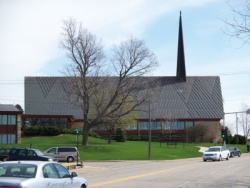Encyclopedia Dubuque
"Encyclopedia Dubuque is the online authority for all things Dubuque, written by the people who know the city best.”
Marshall Cohen—researcher and producer, CNN
Affiliated with the Local History Network of the State Historical Society of Iowa, and the Iowa Museum Association.
WESTMINSTER PRESBYTERIAN CHURCH
WESTMINSTER PRESBYTERIAN CHURCH. Formed from the congregations of two churches. In 1850 twenty pioneers organized the First Presbyterian Church. Five years later seventeen people established the Second Presbyterian Church. First Presbyterian met in a small building at 12th and Main while the Second Presbyterian congregation met for nearly one year in local buildings of the Methodists and Congregationalists.
Growth in both congregations was slow. A brick building was dedicated in 1859 at 13th and Locust, but only the first floor was used. Between 1860 and 1866 only thirty-six new names were added to the church roll. The sanctuary was finally completed in 1869.
Discussions for merging the two churches were begun in the fall of 1903. The final agreement was reached on December 31. Westminster Church first met as a congregation at 13th and Locust with a prayer meeting on January I, 1904.
In the following years, Westminster sponsored the "Park Hill Mission" which later became THIRD PRESBYTERIAN CHURCH. Membership by 1958 had grown to 948 requiring the use of CENTRAL HIGH SCHOOL for overflow classes. As a result on a study conducted by a national church consultant, a site on the hill for relocation was sought near the intersection of two streets. At this time, IRVING ELEMENTARY SCHOOL was moved to Pennsylvania Avenue. Westminster purchased the former location of the school at University and Loras.
Construction began on the church school and fellowship hall in 1958. Services were held in the fellowship hall for six years before construction on the sanctuary began in July 1963. Completed in 1964 at a cost of $250,000, the sanctuary was constructed primarily of redwood and native stone and offered a seating capacity for 650.


